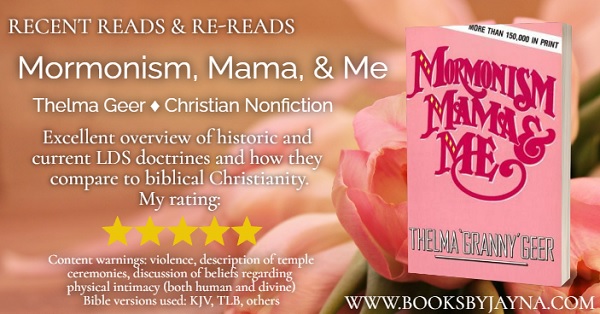Faith is the greatest adventure.

Updates
Excellent overview of historic and current LDS doctrines and how they compare to biblical Christianity. My rating: ★★★★★
Content warnings: violence, description of temple ceremonies, discussion of beliefs regarding physical intimacy (both human and divine) | Bible versions used: KJV, TLB, others | Click here to read full post
It’s fairly common these days, and has been for quite some time, to call a number of things Christian that really aren’t. I am aware of Latter-Day Saints who consider their beliefs compatible with biblical Christianity, and I am also aware that many of them probably do not realize some of what their beliefs actually are. Thelma Geer is quite clear in this book that much of LDS teaching is not publicized to those who are not part of the “inner circle,” so to speak. She also made it quite clear that many early LDS beliefs have been repudiated…or have they?
Here is a quick rundown of some LDS beliefs both past and present:
- God is a common man, like the rest of us, who progressed through the rites and ordinances of Mormonism to reach godhood at some point in the distant past. He populated the earth by means of celestial physical relations with his numerous wives and continues to produce spirit children who await their earthly tabernacles provided by human parents.
- Adam and Eve were the physical children of this Mormon deity and his wives; Adam and Eve in turn became the god and goddess of our earth. If humans obey the rites and ordinances of the LDS faith, they too will eventually become gods and goddesses ruling their own planets and forever populating these worlds through celestial reproduction.
- Jesus Christ and Lucifer were both equal children of this Mormon deity. Jesus became the “Savior” because his plan of salvation was better than Lucifer’s.
- God took on flesh and became the physical father of Christ; Mary was a virgin when this deity visited her but no longer a virgin when he left.
- Baptism is required for the remission of sins. The other LDS laws and ordinances must also be kept. These ordinances can be performed in LDS temples by proxy for ancestors who have died; these ordinances can include eternal marriage to unite ancestors in the spirit realm. LDS youth are regularly baptized to atone for their dead relatives.
As you can hopefully see, these beliefs do not align with the scriptural view of who God is, who Christ is, and what redemption is. Because Geer acknowledged the ways in which LDS teaching changes (and the way new revelations apparently come from the Lord just as societal pressure comes to bear), I wanted to do a bit of research for myself to see what current LDS sites are promoting as their beliefs. I found extremely subtle language that, like Catholicism, uses Christian terms to mean unChristian things. For instance, God is called the “eternal Father.” This sounds very biblical, and it is—until one considers that LDS teaching claims that if God is the everlasting Father as the book of Isaiah states, it must mean he is continually creating spiritual children through ongoing visits to his celestial wives. That is not the Bible’s definition of what everlasting Father means. We are also told that by following Christ, we can become like him. Also very biblical—until one considers that LDS teaching means we literally become deity in the same way LDS teaching says Christ progressed from humanity to Godhood through obedience to LDS doctrine. There is no subtlety about the teaching that baptism is required for remission of sin; that in itself should indicate that LDS doctrine is not biblical Christianity.
I also found evidence of modern-day LDS attempts to whitewash its history. For instance, the church’s official website says regarding race relations, “At some point the Church stopped ordaining male members of African descent, although there were a few exceptions. It is not known precisely why, how or when this restriction began in the Church, but it has ended. Church leaders sought divine guidance regarding the issue and more than three decades ago extended the priesthood to all worthy male members” (emphasis mine). This is patently false. Brigham Young and other early LDS writers made it abundantly clear why men of African descent (whom they called “the seed of Cain”) were not allowed into the Mormon priesthood: in the pre-mortal existence of spirit children, those who were righteous were born into light-skinned bodies, and those who were not righteous were born into dark-skinned bodies. This “evidence” of their earlier wickedness clearly precluded them from priesthood until the “restoration” of the Millennium. This is no secret in early writings and even in LDS scriptures, so for LDS leadership to claim they don’t know why this restriction existed is flimsy at best. They also fail to mention that they did not seek divine guidance on this issue until they realized that their temple project in Brazil would be in serious trouble unless they reversed this earlier restriction.
The official website also claims that many of the beliefs listed above are “caricatures” of the faith, perpetrated by the opposition. Lest Thelma Geer be accused of fabricating these beliefs, she quotes extensively from LDS scriptures and the founders’ writings as well as what she was taught in her childhood. Footnotes are extensive. Modern LDS leadership also tries to claim that accusations of “blood atonement” (the ritual murder of LDS apostates and those whose sins were considered beyond the reach of Christ’s blood or baptismal rites) in the nineteenth century are false and malicious. The extensive evidence in this book suggests otherwise, including quotes from a late-twentieth-century LDS apostle simultaneously repudiating and supporting the concept of LDS blood atonement.
If I write too much more here, I run the risk of rewriting the book, so I will stop here. Note that this book is unashamedly the author’s Christian testimony of coming to true faith in Christ out of Mormonism (the common term at the time of her writing, though LDS is now preferred). Her constant discussion of biblical truth and the glory of Christ’s finished work are bound to rub some people the wrong way, but I personally found it so refreshing to be reminded of all we have in Christ—so often when I’ve known something my entire life, it ceases to be as amazing as it truly is. This book was a good reminder of that. It did seem that some of her discussion of LDS doctrines became repetitious, but perhaps some of that was just building on her previous points in different ways. And those points needed to be made.
This book is not graphic, but it is frank in its discussion of some rather shocking teachings on subjects like eternal intimacy, temple ceremonies, or the administration of blood atonement rituals, so I advise caution for young or sensitive readers. But if you have ever wondered if LDS faith is really just another branch of Christianity, I highly recommend this book. LDS adherents have been strongly advised by their leadership not to read this book, and the author was shunned in her LDS circles despite her compassion for them. I can’t help thinking that’s a reason to consider her words carefully.
Follow my reviews on Goodreads
Happy reading!

